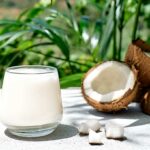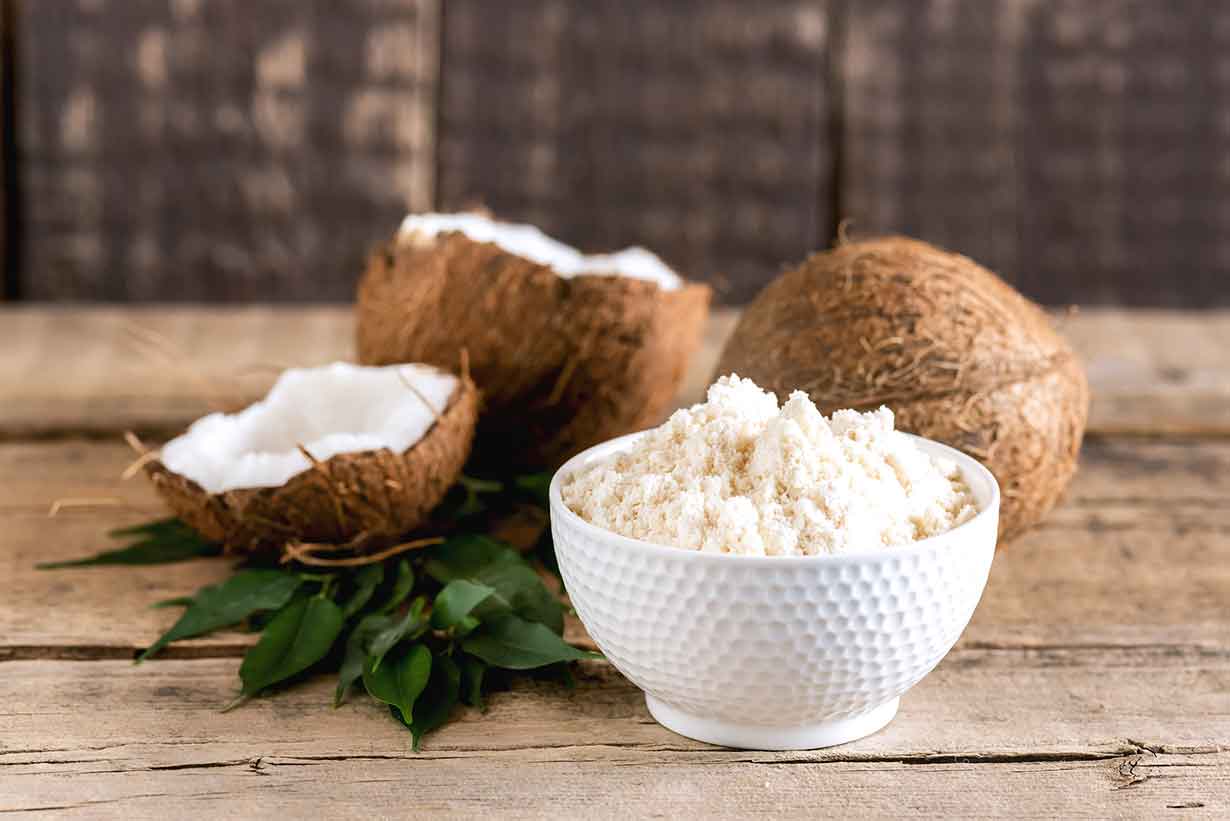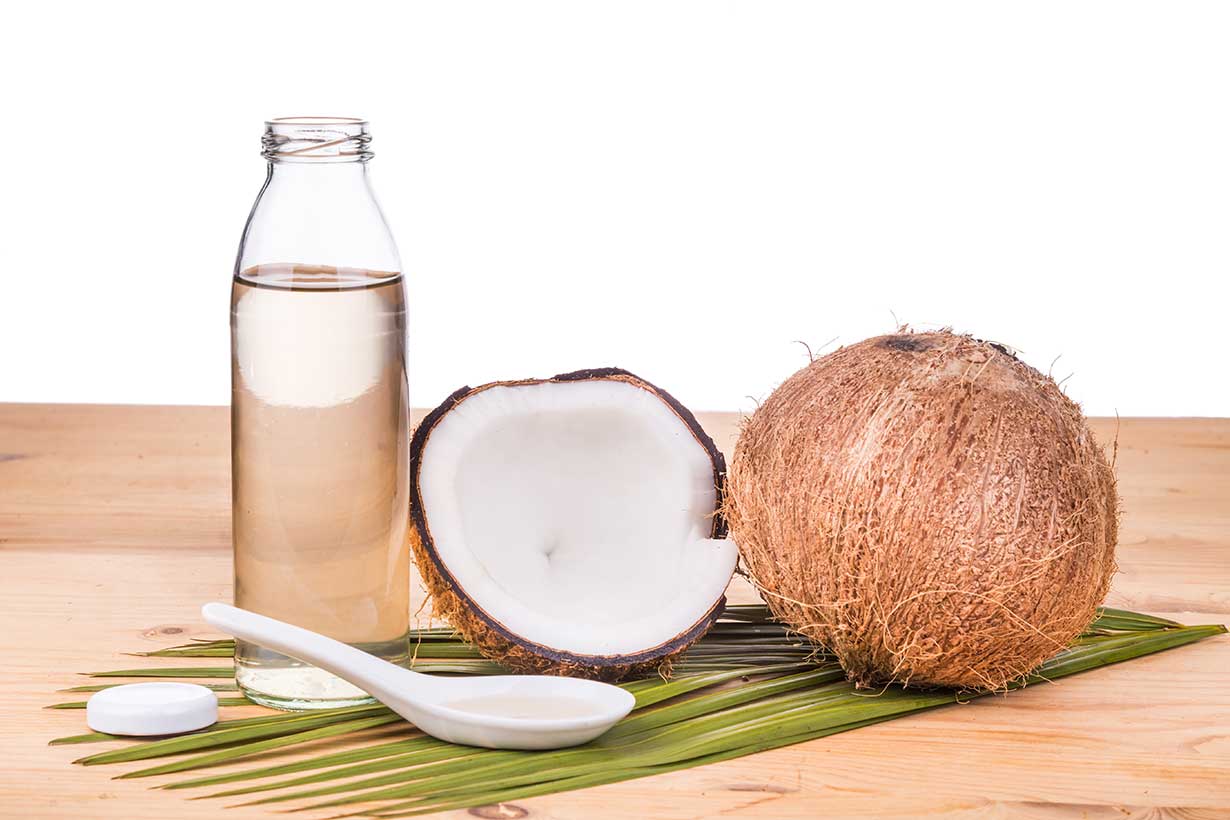There are numerous coconut products used in cooking, ranging from coconut meat to oil, flour, milk, and more. The coconut is indeed one of the most versatile fruits in the human diet.
This article explores the various coconut-based food options, as well as their culinary uses and key nutrition facts.

Table of contents
1) Coconut Aminos

Coconut Aminos is created by mixing coconut tree sap with salt and then allowing it to ferment.
Over time, this liquid transforms into a dark, salty liquid rich in umami flavors. In fact, Coconut Aminos resembles soy sauce in taste, making it a suitable alternative for culinary use.
Whether you’re enhancing the flavor of a dish or using it as a dipping source, Coconut Aminos adds lots of flavor.
In terms of nutritional composition, here are the key nutrition facts for Coconut Aminos, presented both per 100 grams and per 5-gram serving:
| Name | Per 100g | Per 5g serving |
|---|---|---|
| Calories | 100 kcal | 5 kcal |
| Carbohydrates | 20.0 g | 1 g |
| Fiber | 0 g | 0 g |
| Sugars | 20.0 g | 1 g |
| Fat | 0 g | 0 g |
| Saturated | 0 g | 0 g |
| Monounsaturated | 0 g | 0 g |
| Polyunsaturated | 0 g | 0 g |
| Protein | 0 g | 0 g |
| Sodium | 1800 mg | 90 mg |
As the table indicates, Coconut Aminos serves primarily as a source of carbohydrates, with 5 calories per serving and a high sodium content.
To learn more about Coconut Aminos, see this guide here:
What Is Coconut Aminos? A Tasty Soy Sauce Substitute
2) Coconut Butter
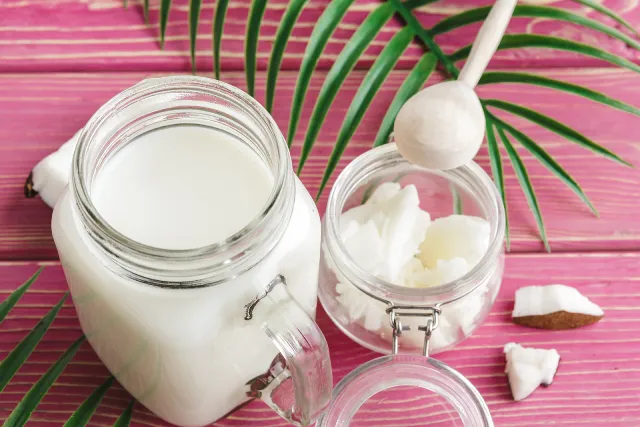
Coconut butter is an interesting coconut product created by blending dried or dessicated coconut until it transforms into a thick paste.
As the paste continues to blend, the paste will develop a smoother and creamier texture, and at this stage it becomes ‘coconut butter.’
Notably, coconut butter is a versatile food product and can be used as an ingredient in recipes or even as a condiment.
In other words, you can find it in various baking and curry recipes, and it can used as a topping to spread onto food.
Here are the key nutritional values for coconut butter, presented per 100 grams and per ounce (28.35g) serving:
| Name | Per 100g | Per ounce (28g) serving |
|---|---|---|
| Calories | 643 kcal | 180 kcal |
| Carbohydrates | 25.0 g | 7.0 g |
| Fiber | 14.3 g | 4.0 g |
| Sugars | 7.14 g | 2.0 g |
| Fat | 64.3 g | 18.0 g |
| Saturated | 53.6 g | 15.0 g |
| Protein | 7.14 g | 2.0 g |
| Sodium | 36 mg | 10.1 mg |
Since coconut butter is derived from the whole coconut meat, it contains carbohydrates, fat, and protein.
However, it is primarily a source of (saturated) fat.
For a deep and comprehensive guide to coconut butter, please refer to the following article:
What Is Coconut Butter? Nutrition and Uses
3) Coconut Cream
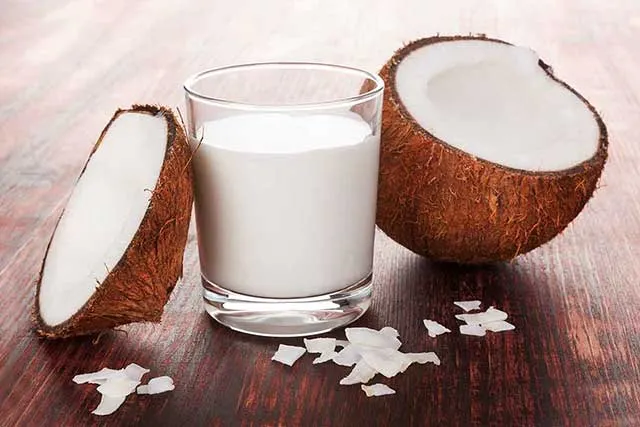
Coconut cream is a relatively lesser-known coconut products.
While most people are familiar with coconut milk, fewer have knowledge of coconut cream.
To elucidate, coconut cream is created by mixing shredded coconut flesh with water and subsequently straining the liquid out of it. The end result is a thick and creamy mixture known as coconut cream.
Coconut cream has a pleasant, creamy taste, and it works as an effective thickener in numerous dishes. It also gives any dish a creamier mouthfeel, hence its widespread use in curries, soups, and stews.
Here are the nutritional properties of coconut cream, presented per 100 grams and per 15-gram tablespoon:
| Name | Per 100g | Per 15g tablespoon |
|---|---|---|
| Calories | 330 kcal | 50 kcal |
| Carbohydrates | 6.65 g | 1.0 g |
| Fiber | 2.20 g | 0.33 g |
| Sugars | 4.24 g | 0.64 g |
| Fat | 34.68 g | 5.20 g |
| Saturated | 30.75 g | 4.61 g |
| Monounsaturated | 1.48 g | 0.22 g |
| Polyunsaturated | 0.38 g | 0.06 g |
| Protein | 3.63 g | 0.54 g |
| Sodium | 4.0 mg | 0.60 mg |
As indicated in the table, coconut cream boasts significantly more calories than coconut milk.
It is primarily a source of fat, but does contain a modest amount of carbohydrates and protein.
4) Coconut Flakes (Sweetened)
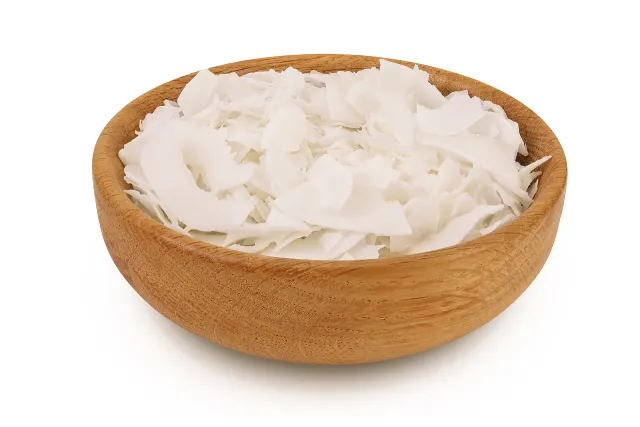
Coconut flakes are thin, white pieces of coconut meat obtained from grating the coconut meat.
These slice-like ‘coconut flakes’ are then typically dried before packaging to give them a longer shelf life. In the context of sweetened coconut flakes, sugar is added during this process.
Coconut flakes are quite versatile, and they find their way into cereals like granola, trail mixes, and a variety of desserts.
Nutritionally, here are the details for sweetened coconut flakes per 100 grams and per ounce (28.35g) serving:
| Name | Per 100g | Per ounce (28.35g) |
|---|---|---|
| Calories | 456 kcal | 129 kcal |
| Carbohydrates | 51.8 g | 14.7 g |
| Fiber | 9.9 g | 2.81 g |
| Sugars | 36.8 g | 10.4 g |
| Fat | 28.0 g | 7.94 g |
| Saturated | 26.4 g | 7.48 g |
| Monounsaturated | 1.38 g | 0.39 g |
| Polyunsaturated | 0.22 g | 0.06 g |
| Protein | 3.13 g | 0.88 g |
| Sodium | 285 mg | 80.8 mg |
Coconut flakes are rich in both carbohydrates and fat, with a smaller quantity of protein. Since these nutritional details pertain to sweetened coconut flakes, they also have a high sugar content.
Most of their fat content comes from saturated fat, and they also provide a moderate amount of dietary fiber.
5) Coconut Flour
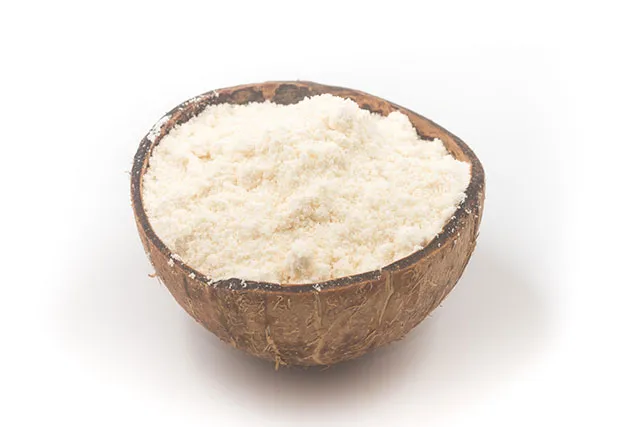
Created by finely grinding dried and defatted coconut meat, coconut flour is a popular gluten-free baking option.
Beyond its use in baking, coconut flour is also an effective thickener in cooked dishes. Some individuals may also use it for making gluten-free or low-carbohydrate breadcrumbs.
The table below displays the nutritional properties of coconut flour, presented per 100 grams and per 112-gram cup:
| Name | Per 100g | Per 112g cup |
|---|---|---|
| Calories | 429 kcal | 481 kcal |
| Carbohydrates | 64.29 g | 72.01 g |
| Fiber | 35.71 g | 40.0 g |
| Sugars | 21.43 g | 24.0 g |
| Fat | 10.71 g | 12.0 g |
| Saturated | 7.14 g | 8.0 g |
| Monounsaturated | 0.46 g | 0.5 g |
| Polyunsaturated | 0.12 g | 0.13 g |
| Protein | 21.43 g | 24.0 g |
| Sodium | 71.0 mg | 79.52 mg |
As depicted in the table, coconut flour is primarily a source of carbohydrates, and it is very high in fiber.
However, it also offers a moderate provision of fat and protein.
For an extensive guide to coconut flour, its vitamin and mineral profile, please refer to the resource below:
Coconut Flour: Nutrition Benefits, Drawbacks, and How To Use It
6) Coconut Meat
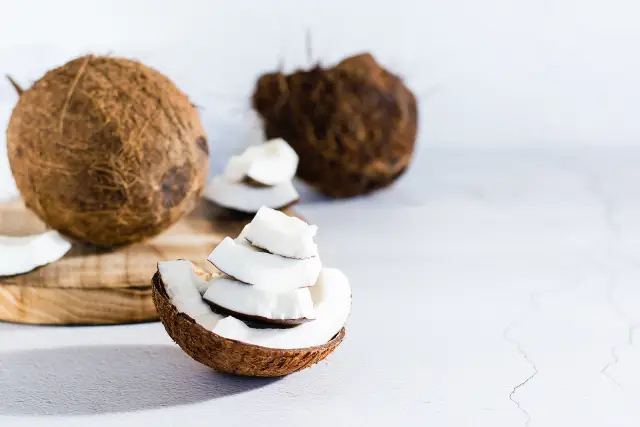
Coconut meat, often referred to as ‘coconut flesh’ or simply ‘coconut,’ is the inner white flesh of a mature coconut. It may also be called ‘coconut flesh’ or simply ‘coconut.’
Its texture is slightly hard, firm, and somewhat chewy. Whether enjoyed raw or cooked, it imparts a slightly sweet taste and a hint of nuttiness to dishes.
Coconut meat is a versatile ingredient, and it can be the base for making many of the other coconut products at home.
It can also be grated on top of a dish, added to cooked dishes like curries, blended into smoothies, or simply enjoyed by itself as a snack.
Coconut meat offers the following nutritional values per 100 grams and per 45-gram piece serving:
| Name | Per 100g | Per 112g cup |
|---|---|---|
| Calories | 354 kcal | 159 kcal |
| Carbohydrates | 15.2 g | 6.84 g |
| Fiber | 9.0 g | 4.05 g |
| Sugars | 6.23 g | 2.8 g |
| Fat | 33.5 g | 15.1 g |
| Saturated | 29.7 g | 13.4 g |
| Monounsaturated | 1.42 g | 0.64 g |
| Polyunsaturated | 0.37 g | 0.17 g |
| Protein | 3.33 g | 1.5 g |
| Sodium | 20 mg | 9 mg |
Coconut meat is primarily a source of fat, but it also has a moderate carbohydrate content and a small amount of protein.
7) Coconut Milk
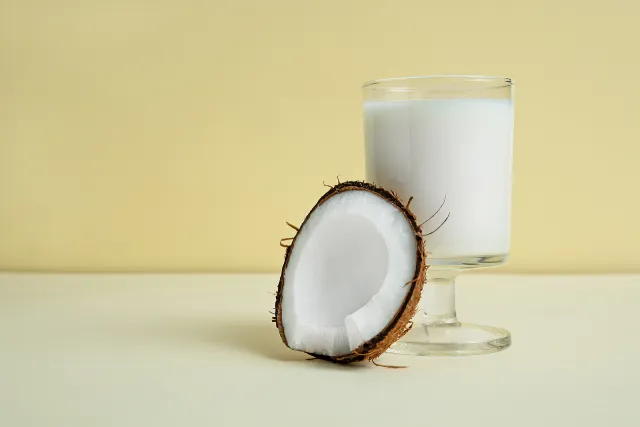
Coconut milk is one of the most popular coconut-based food products. It is a white fluid obtained by straining the grated flesh of coconut meat.
While coconut milk is similar in taste to coconut cream, it is not as thick and creamy.
The reason for this is because, during its production, coconut milk has significantly more water added to it, resulting in a more fluid, runny consistency.
Among its various uses, coconut milk features in a wide range of savory dishes, desserts, and beverages. It is a staple in many Asian cuisines, and is often features in curries, where it provides a creamier texture and a milder taste.
Here are the nutritional properties of a typical canned coconut milk per 100 grams and per 30-gram fluid ounce:
| Name | Per 100g | Per 30g fluid ounce |
|---|---|---|
| Calories | 230 kcal | 69 kcal |
| Carbohydrates | 5.54 g | 1.66 g |
| Fiber | 2.2 g | 0.66 g |
| Sugars | 3.34 g | 1.0 g |
| Fat | 23.84 g | 7.15 g |
| Saturated | 21.14 g | 6.34 g |
| Monounsaturated | 1.01 g | 0.30 g |
| Polyunsaturated | 0.26 g | 0.08 g |
| Protein | 2.29 g | 0.69 g |
| Sodium | 15 mg | 4.5 mg |
Coconut milk has 69 calories per 30-gram fluid ounce and it is primarily a source of fat.
Beyond its role as an ingredient, you can also find coconut milk drinks on the market. These have a significantly higher water content and a thinner texture.
For a comprehensive guide to coconut milk, refer to the below article:
Is Coconut Milk a Healthy Choice?
8) Coconut Oil
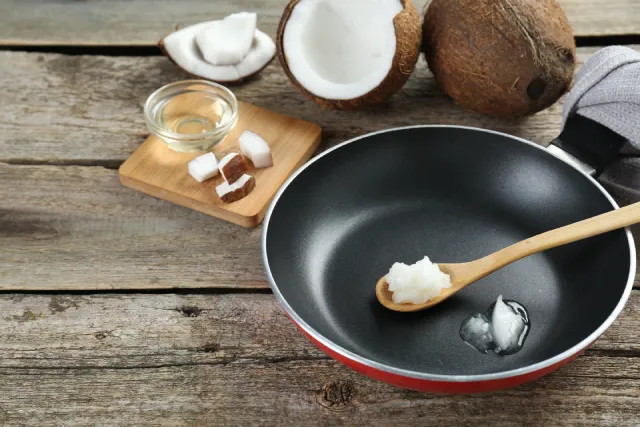
Coconut oil has witnessed increasing popularity in the United States and Europe over the past decade or two. However, it has long been a staple cooking oil in several Southeast Asian and Pacific Rim countries (1).
Similar to the production of other edible oils, coconut oil is obtained by extracting the fat from the white flesh of coconuts. This may be accomplished through either cold-pressing or solvent extraction methods (2).
While coconut is solid at a typical room temperature, it becomes a liquid at temperatures above 78°F (25.5°C) (3).
As with other edible oils, coconut oil has many uses and people employ it for deep-frying, marinating, pan-frying, and roasting food. It is also a popular oil in cosmetic products due to its moisturizing properties.
The nutritional composition of coconut oil, per 100 grams and per 14-gram tablespoon, is detailed below:
| Name | Per 100g | Per 30g fluid ounce |
|---|---|---|
| Calories | 895 kcal | 125 kcal |
| Carbohydrates | 0.84 g | 0.12 g |
| Fiber | 0 g | 0 g |
| Sugars | 0 g | 0 g |
| Fat | 99.1 g | 13.9 g |
| Saturated | 82.5 g | 11.6 g |
| Monounsaturated | 6.31 g | 0.88 g |
| Polyunsaturated | 1.7 g | 0.24 g |
| Protein | 0 g | 0 g |
| Sodium | 0 mg | 0 mg |
Coconut oil is almost 100% fat, mostly saturated.
9) Coconut, Shredded (Unsweetened)
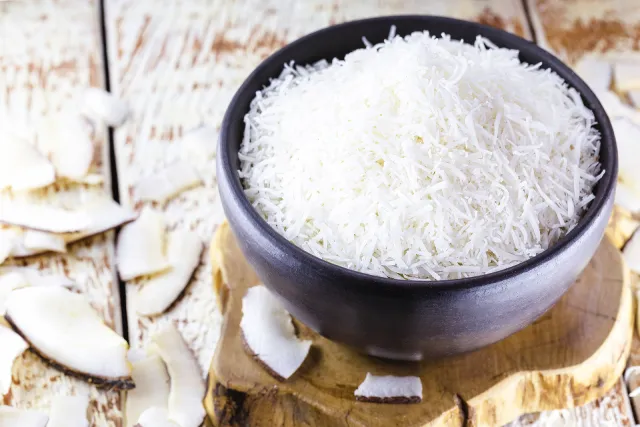
For those who may wonder, shredded coconut is essentially interchangeable with coconut flakes. The key difference between these two lies in the size; coconut flakes tend to be larger pieces, while shredded coconut is more finely cut.
The ‘unsweetened’ version of shredded coconut (and coconut flakes) provide a similar experience, but with an unsweetened taste. It thus has less added sugar, and more fat from the higher coconut content.
With this in consideration, there are also some nutritional distinctions.
Here is the nutritional composition of unsweetened shredded coconut, both per 100 grams and per ounce (28.35g) serving:
| Name | Per 100g | Per ounce (28.35g) |
|---|---|---|
| Calories | 660 kcal | 187 kcal |
| Carbohydrates | 23.65 g | 6.70 g |
| Fiber | 16.30 g | 4.62 g |
| Sugars | 7.35 g | 2.08 g |
| Fat | 64.53 g | 18.29 g |
| Saturated | 57.22 g | 16.22 g |
| Monounsaturated | 2.75 g | 0.78 g |
| Polyunsaturated | 0.71 g | 0.20 g |
| Protein | 6.88 g | 1.95 g |
| Sodium | 37.0 mg | 10.49 g |
10) Coconut Vinegar
Coconut vinegar is another one of the lesser-known coconut products.
The production process is similar to Coconut Aminos, with the initial step involving the fermentation of coconut tree sap.
However, when making coconut vinegar, the fermented coconut sap is filtered and then left to age over several months.
Much like with other vinegar products, coconut vinegar has a versatile range of culinary uses. Among these, it can be an ingredient in dips, marinades, salad dressings, and various types of sauce.
Coconut vinegar has the following nutritional profile per 100 grams and per 15-ml tablespoon:
| Name | Per 100g | Per 15-ml tablespoon |
|---|---|---|
| Calories | 67 kcal | 10 kcal |
| Carbohydrates | 13.33 g | 2.0 g |
| Fiber | 0 g | 0 g |
| Sugars | 13.33 g | 2.0 g |
| Fat | 0 g | 0 g |
| Saturated | 0 g | 0 g |
| Monounsaturated | – | – |
| Polyunsaturated | – | – |
| Protein | 0 g | 0 g |
| Sodium | 0 mg | 0 mg |
For more on coconut vinegar, see the following guide:
Coconut Vinegar: What is It and What Does It Offer?
11) Coconut Water
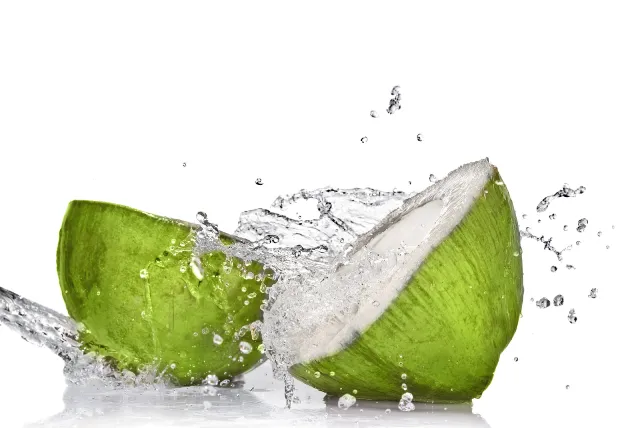
Coconut water is another popular coconut product. This refreshing beverage is obtained from the naturally present water inside green coconuts.
With a small sugar content, it boasts a slightly sweet, coconutty taste.
Nutritionally, coconut water offers a good range of electrolyte minerals, with a notable provision of potassium (4).
Here are the nutritional values of coconut water per 100 grams and per 240-gram cup:
| Name | Per 100g | Per 245g cup |
|---|---|---|
| Calories | 18 kcal | 44 kcal |
| Carbohydrates | 4.24 g | 10.4 g |
| Fiber | 0 g | 0 g |
| Sugars | 3.92 g | 9.6 g |
| Fat | 0 g | 0 g |
| Saturated | 0 g | 0 g |
| Monounsaturated | 0 g | 0 g |
| Polyunsaturated | 0 g | 0 g |
| Protein | 0.22 g | 0.54 g |
| Sodium | 26 mg | 64 mg |
Learn more: 4 Science-Backed Benefits of Coconut Water (and Nutrition Facts)
12) Creamed Coconut
Creamed coconut is essentially the same as coconut butter in terms of coconut composition and nutritionally.
However, it differs in texture, as it is dehydrated into a solid bar-shaped design. This makes it easy to chop little bits of creamed coconut for use in a dish, or for grating as a topping for food.
Once it gets warmer when exposed to heat, a piece of creamed coconut will start to melt and develop the same texture as coconut butter. This may also happen to the whole creamed coconut bar in warmer climates above typical room temperature.
Here are the nutritional values for creamed coconut, which mirror those of coconut butter:
| Name | Per 100g | Per ounce (28.35g) serving |
|---|---|---|
| Calories | 684 kcal | 194 kcal |
| Carbohydrates | 21.5 g | 6.1 g |
| Fiber | – | – |
| Sugars | – | – |
| Fat | 69.1 g | 19.6 g |
| Saturated | 61.3 g | 17.4 g |
| Monounsaturated | 2.94 g | 0.83 g |
| Polyunsaturated | 0.76 g | 0.21 g |
| Protein | 5.3 g | 1.5 g |
| Sodium | 37 mg | 10.5 g |
13) Toasted Coconut Chips
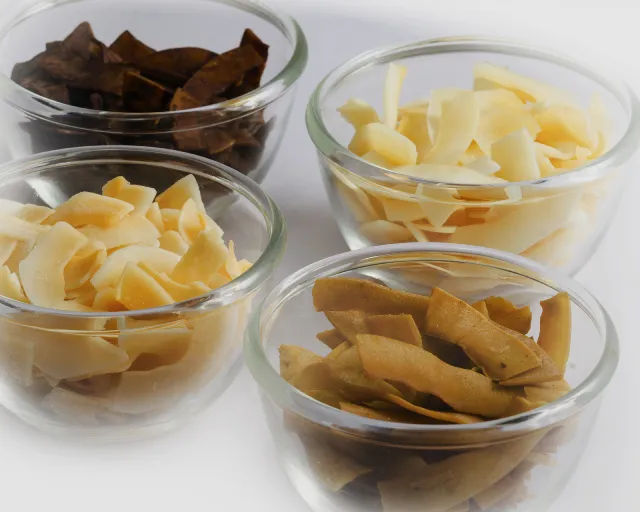
Toasted coconut chips are a popular coconut-based snack product, known for their crispy and enjoyable flavor.
As for their composition, these chips are simply toasted coconut flakes, which may or may not have been sweetened.
Coconut chips are also available in a wide variety of flavors, ranging from chocolate-infused coconut chips to spicy cayenne varieties, and more.
Here are the typical nutritional values of plain, toasted coconut chips, displayed per 100 grams and per ounce (28-gram) serving:
| Name | Per 100g | Per ounce (28.35g) serving |
|---|---|---|
| Calories | 553 kcal | 157 kcal |
| Carbohydrates | 53.6 g | 15.2 g |
| Fiber | 10.0 g | 2.8 g |
| Sugars | 42.8 g | 12.1 g |
| Fat | 39.3 g | 11.1 g |
| Saturated | 34.6 g | 9.8 g |
| Monounsaturated | 1.7 g | 0.5 g |
| Polyunsaturated | 0.4 g | 0.1 g |
| Protein | 4.3 g | 1.2 g |
| Sodium | 603 mg | 171 mg |
Final Thoughts
As illustrated in this article, a wide range of coconut products are available, each suited for a versatile range of culinary purposes.
Whether it’s adding creaminess to a cooked dish, enjoying a snack, making a marinade, or more – there’s a coconut product to meet many needs.


